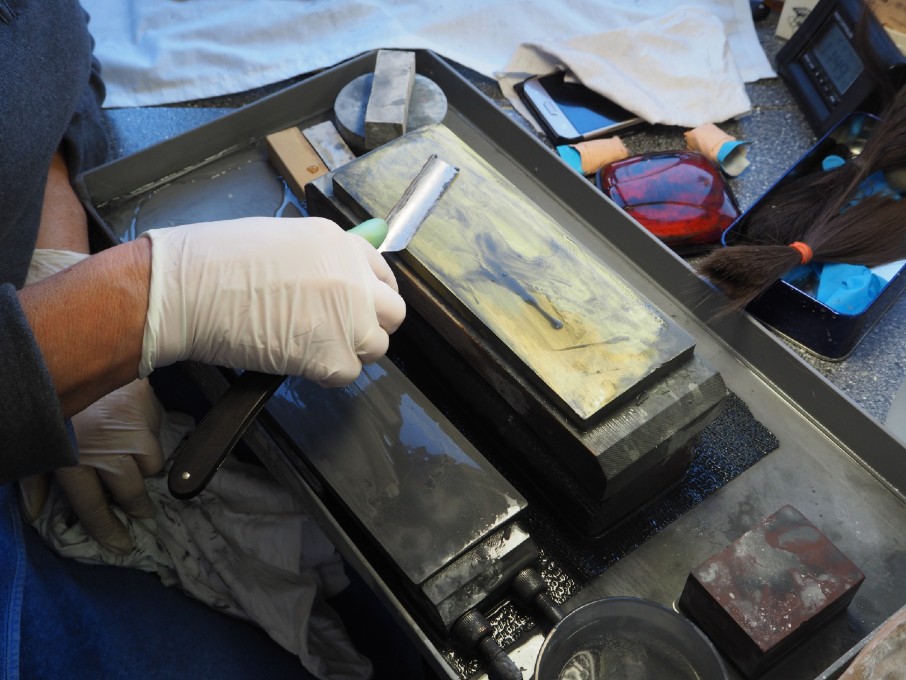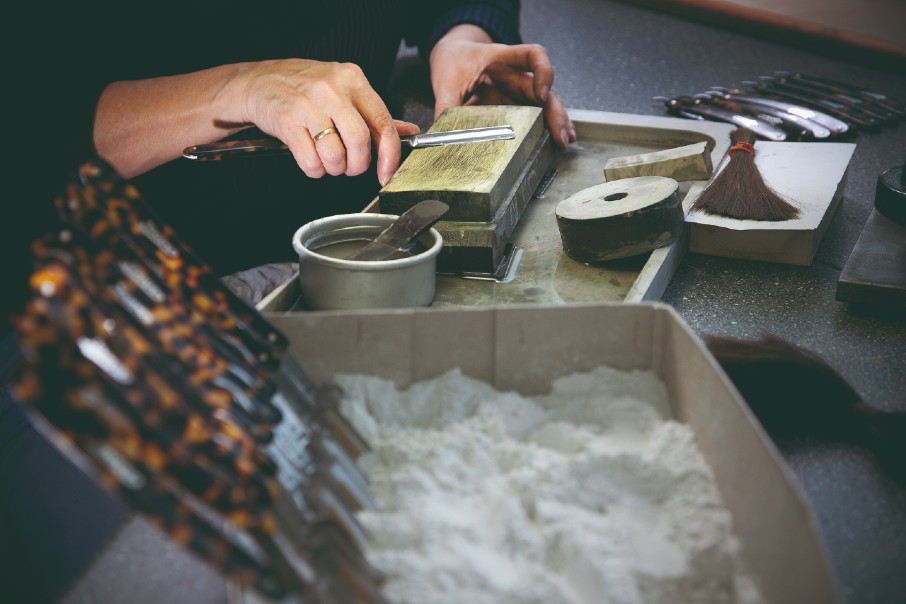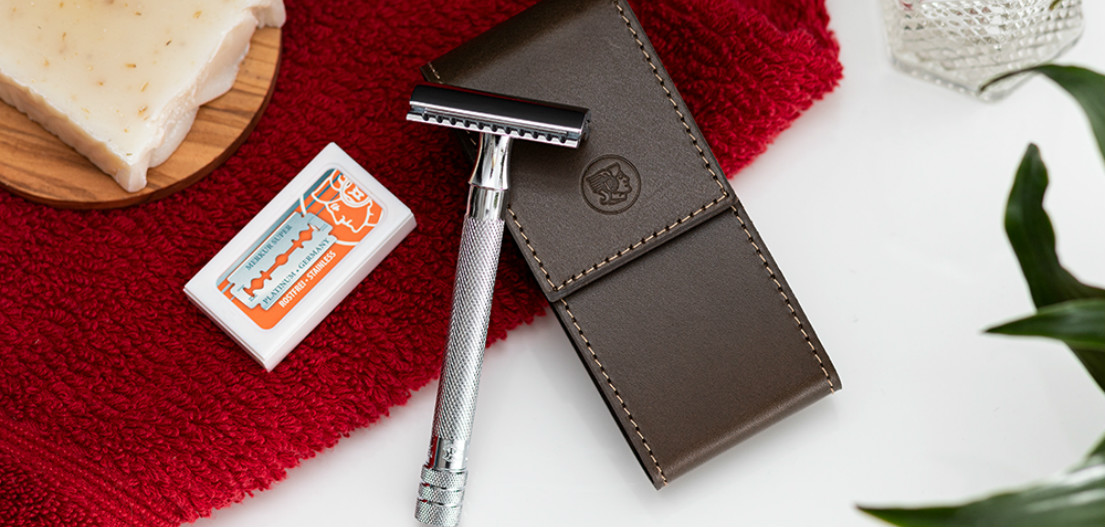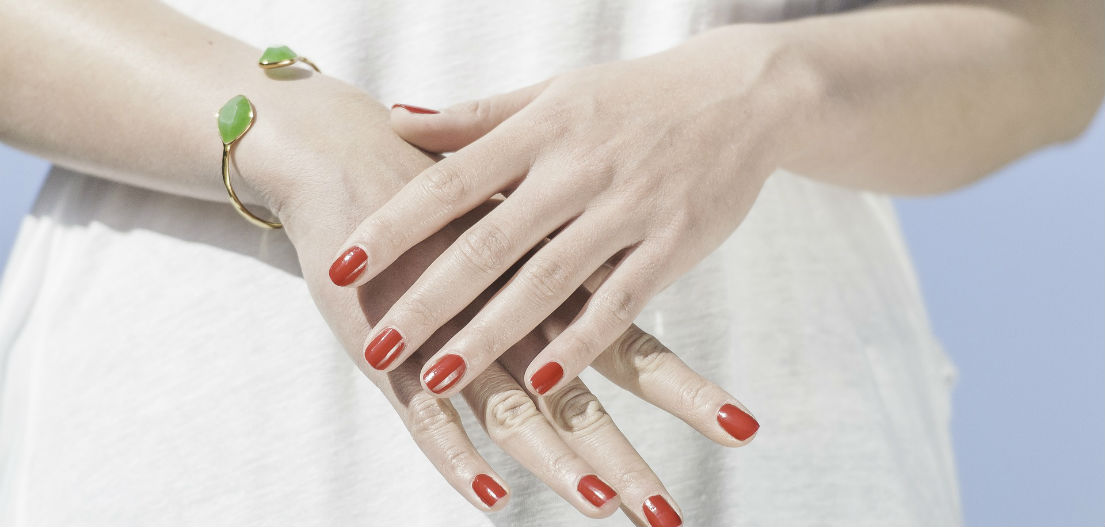Even if you have just started to deal with straight razors, you have probably already heard someone talk about the so-called hanging hair test. And terms like “ready to shave” or “shave ready condition” have already flown around your ears. In this blog, we give you a heads up – and clear up a few myths …
A short theory lesson
So that we can answer all your questions about the sharpness of a straight razor, we first have to do a short theory crash course. Because even though a lot has to do with your personal preferences when shaving, some other things are simply physics, geometry and materials science. Grab a pen and notebook and we are off to the races…
How is sharpness defined?
If we want to get a closer understanding of the term sharpness, we must first enter the realm of geometry:
Imagine 2 levels running towards each other and meeting at one end. The resulting acute-angled triangle defines the cutting edge and its sharpness is related to the angle of this triangle. The more pointed this triangle is, the sharper it becomes. If you cut something with a knife, it is also called “wedge cutting” because you drive your knife through the material like a wedge. The wider this wedge is, the more difficult it becomes to cut something with it.
But what does all this mean for the straight razor?
The angles of a straight razor must be ground evenly so that the tip of the blade can cut your hair in the best possible way. Of course, you always have to choose a compromise between sharpness and the blade´s ability to hold an edge, which is why we grind our blades approximately at a 15° angle. We use this angle because it is the perfect middle ground so that we can combine a long-lasting edge holding ability and a perfect shaving sharpness.
As you have probably already guessed, we cannot talk about sharpness without mentioning the topic of grinding and honing. With our blades, you have already read terms such as “full hollow ground” or “half-hollow ground”.
This refers to the concave grinding technique of the blade. In easy words, we “hollow” the blade, so that you have the advantage of a more flexible blade. Your face is not an even surface, there are contours, dimples, wrinkles and many different angles. Thanks to the hollow grinding and the resulting slightly flexible blade, our straight razors glide effortlessly over your face. This supports you in finding the correct angle and to achieve one goal: A thorough and gentle shave.
If you want to find out more about the complex types of grinding, take a look at this blog.
It is necessary to use the right balance between longevity and suitability for shaving. If we were to sharpen a blade even thinner, the microscopic bevel would no longer be able to withstand the challenges of regular shaving and the straight razor edge would be blunt after a short time.

Hardness and ability to hold an edge
When straight razor lovers talk about a blade’s ability to hold an edge, the question is how long a straight razor stays sharp. So how long a sharpened straight razor can withstand the stress of shaving before you have to sharpen it again.
Many things have to be considered here. On the one hand, aspects that affect the straight razor itself, such as the material of the blade or the grind. But of course, there are also other aspects to consider: What material are you going to cut? How do you cut it? How is the blade cared for?To tackle those aspects you have to find a suitable compromise while designing a blade. With our straight razors made of carbon steel, such as the Bergische Löwe, for example, you can expect a hardness of around 61 HRC. The blade’s ability to hold an edge and its sharpness are in perfect balance for regular shaving. Of course, we could use even harder steel for the blades, but then the blades would lose the flexibility to make a gentle shave even possible.
What is a “shave ready condition”?
Straight razor veterans with decades of experience have developed an enormous feeling and understanding of the nature of the steel.
But since we want to include the newcomers just as warmly in our midst, let’s try a definition:
For us at DOVO, “shave ready condition” means that a straight razor is so sharp that it can easily cut facial hair and guarantees a comfortable shave.
Hanging hair test vs. The feeling of a shave
Ah, the good old hanging hair test. With it, you clamp a head hair between the nails of your thumb and index finger and tackle it with your straight razor at a 90° angle directly above the nails. If you can grasp and cut the hair with the blade, the test is passed.
We subject all blades to this test after production. However, we are aware of the fact that the hanging hair test on its own does not provide comprehensive information about the quality of a blade. In itself, you only test whether a blade passes the hanging hair test – but not if the blade is already in shave ready condition.
If sharpness would be the only criteria for achieving a great shave, then we should all shave with a diamond blade or a lightsaber. But we don´t, and there are good reasons for this:
Decisive for a comfortable shave is not the sharpness alone, more important are the characteristics as a whole. A straight razor should not only cut facial hair but also gently nestle against your face. If your straight razor would be made of extremely hard, inflexible steel, this would no longer be possible and your shave would be torture. Aspects such as the ability to hold an edge, the price, the skin tolerance or the user-friendliness concerning taking care of the blade must also be considered in the development of a new straight razor. Don’t forget that a new blade has to break in a little before it can reach its full potential.

Sharpening and stropping
All straight razors are sharpened by hand by experienced employees in five stages from rough to fine, then stropped and checked.
On the first grinding plate, the bevel is ground to the 0.1mm thin blade with 320 grain, followed by the second step with 1,000 grain on the second grinding plate. This is followed by the steps 5,000, 8,000 and 10,000 on the whetstones. Last but not least, we strop the blades on a leather strop with iron-oxide paste. This creates the fine bevel which effortlessly grabs and cuts your hair.
We also get questions about the strop more often. A strop, like our “185”, is not intended to sharpen your straight razor. Every time you shave, you injure the microscopic bevel of your blade – your skin and hair bend the bevel, causing small furrows and fringes.
By leaving the straight razor to rest after shaving for at least 48 hours, a large part of the bevel raises on its own again. However, to ensure a perfectly uniform bevel again, the blade is gently stropped over a leather strap. The maltreated metal is gently stroked back into its desired position and you polish its bevel lightly. The shaving ability of your straight razor is preserved longer.

How do you sharpen your straight razor?
How often you should have your blade sharpened, is strongly related to how often you use it and how you handle it.
A well-maintained straight razor can be used for more than a year without having to have it sharpened. However, if you shave every two days or don’t take good care of it, the time interval can of course also be shorter. Sharpening is also necessary if you drop your straight razor and the bevel is injured.
Unfortunately, we often notice that new users are not used to handling straight razors and therefore make mistakes when shaving, stropping or taking proper care of them. This means that the sharpness of a straight razor can be ruined in no time. Shaving with a straight razor is a beautiful, thorough and almost meditative process of personal hygiene and can be mastered wonderfully with some experience. With a little practice, patience and reading our blogs, you will quickly achieve success and you will no longer want to miss your straight razor.
An important message for newcomers:
If you are new to straight razor sharpening, please contact our repair and sharpening service or an experienced member of the community – only then you will enjoy your straight razor for a long time.
If you want to learn the art of sharpening yourself, the best thing to do is to get an old straight razor from the flea market. This way you can safely practice your sharpening skills before venturing to your best straight razor.
Are DOVO straight razors in a shave-ready condition?
Yes, all our straight razors leave the company in such a way that you can start shaving immediately.
As a company, we not only have a 114-year long tradition of producing the finest straight razors, but our employees are experienced razor grinders and love straight razors just as much as you do. Trust our many years of expertise and enjoy a high-quality DOVO straight razor from Solingen. And if there are any ambiguities, we are always at your side and will help you as much as we can – we look forward to hearing from you!






